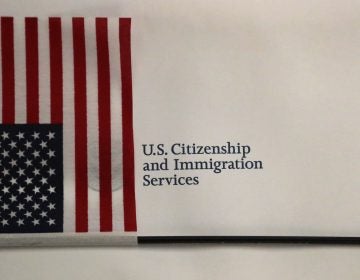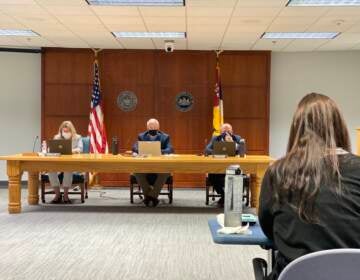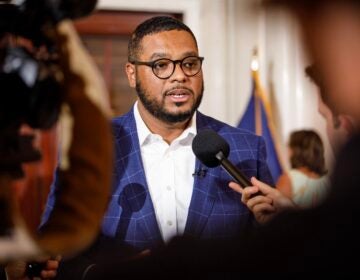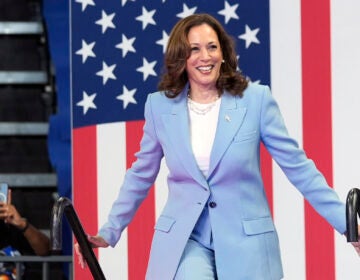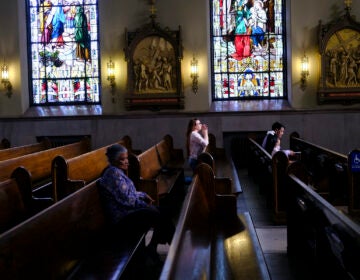New census numbers herald potential political power for Philadelphia’s growing Latino, Asian populations
The last decade brought Philadelphia its biggest population jump since 1950. The number of Black and white residents declined, while Latino and Asian numbers spiked.

Shown is the skyline in Philadelphia along the Schuylkill River, Tuesday, April 9, 2019. (Matt Rourke/AP Photo)
Philadelphia is reversing its decades-long trend of population loss, new U.S. Census numbers confirmed this month, showing the change is almost entirely due to huge growth among Latino and Asian communities.
Government agencies, politicians, nonprofits, and many others are busy analyzing the new data. In the coming weeks and months, their findings will inform everything from massive infrastructure projects to the candidates who are likely to turn up on the next ballot.
The political implications were top of mind for City Councilmember Maria Quiñones-Sánchez.
In her North Philly district, it’s long been clear that new groups of Latinos are arriving, she said, and “you can feel … the growing presence of the Asian community.” She hopes the now-official count spurs the city and fellow politicians to make changes in how they engage these growing communities.
“This is a majority Black and brown city,” Quiñones-Sánchez said. “For me, the [census] numbers are an opportunity to continue to highlight why these communities need support and investment, because they will be the ones that will help the city recover.”
She’s referring to recovery from the pandemic — but also from decades of population decline.
The last decade brought Philly its biggest population jump since 1950. The increase was relatively modest: Between 2010 and 2020, the city added 78,000 residents, growing a little over 5% to a total of about 1.6 million. But it’s a big deal for a city that saw consistent population outflow from 1960 to 2000, and showed only modest growth in the previous census.
Philadelphia’s growth this time around was not evenly distributed. In fact, numbers show a 7% decline in white residents and a 5% drop in Black residents.
The decreases were offset by a more than 27% (50,700-person) increase in the population of people who classified themselves as Hispanic or Latino and a nearly 39% increase in Asian residents (36,900 people). The number of people classifying themselves as multiracial skyrocketed as well — likely in part due to updates in how the census processes that data. Philadelphia’s total population remains about 36% white and 39% Black.
Those trends were broadly reflected in Philadelphia’s four collar counties, too: rising population, with Asian and Latino groups leading the increase. Bucks, Montgomery, Delaware, and Chester counties all had modest population increases — 3.4%, 7.1%, 3.2%, and 7.1% respectively.
And in all four, numbers of white residents decreased at least slightly, while Latino/Hispanic and Asian populations rose. Bucks, Delaware, and Montgomery also saw their Black populations increase. Because the suburbs share some infrastructure and elected state officials with Philadelphia, population and demographic shifts are generally seen as connected.
Councilmember: Philly’s power structure is too old, too white, too set in its ways
Will González heads Ceiba, a Philly-based coalition of Latino advocacy groups. For him, seeing robust growth in census results was something of a relief.
The census-taking process was disrupted by the pandemic, as well as the Trump administration’s high-profile attempt to include a question about citizenship status — a move many said could prompt undocumented immigrants to skip the survey and lead an undercount.
“It’s just reality,” González said of the final count. “I think it’s a fair assessment of what the community is now, [and] of the strength of this community.”
The extent of the growth came as a surprise to Ben Gruswitz of the Delaware Valley Regional Planning Commission, which advises Philadelphia and surrounding counties on long-term infrastructure. He’s been leading the DVRPC’s analysis of the new census numbers, which will inform many plans going forward.
In recent years, Gruswitz said, unofficial estimates had been pointing to much smaller increases, or even a modest decline. Instead, the reverse happened — in Philadelphia and other U.S. cities.
“It sounds like that’s the case [in] a lot of more urban areas of the country,” he said. “And [population growth] was lower in more rural areas that might have been expecting more growth.”
Brett Fusco, who heads the DRVPC’s long-range transportation planning, said immigration-driven population increases were already a big part of the commission’s effort — and the new numbers show they’re on the right track.
“With immigrants to the region, we’re finding a lot more willingness to walk, to take transit,” he said. “It definitely plays into our thinking. We’re trying to think, you know, what is the population of the future? What does it look like? What are the travel needs for that for those populations?”
People like González, of Ceiba, and Quiñones-Sánchez, the North Philly councilmember, are also thinking about the future needs of Philly’s immigrant communities — less in terms of trains, and more in terms of political and institutional power.
González would like to see more Latinos in elected office. He’s also looking forward to a time when businesses see Latinos as consumers to be courted.
“Business relies on the census a lot,” he said. “And so now when they do outreach and marketing, they’ll make sure to incorporate elements that speak to the Latino community. Obviously, bilingualism is part of that — it’s not just a knee-jerk reaction that everything has to be in Spanish oriented to the Latino community. It’s a multicultural, bilingual [city].”
When it comes to viewing Asian and Latino groups in terms of votes, Quiñones-Sánchez noted, it’s not particularly helpful to make broad assumptions about the diverse constituencies from a wide range of countries and backgrounds.
In the wake of Hurricane Maria, for example, a lot of Puerto Rican people came to Philadelphia to start over. Those are people who can already vote, Quiñones-Sánchez said, and they may have a different experience adjusting to the city than “the growing Dominican and Mexican and other populations.” Those people, as a result, may have a different take on politics than Latinos who have already been in Philly for several generations.
“I never want the Democratic Party to become complacent,” she said. “I want to challenge them to do better outreach to our communities about why our agendas, agendas in urban cities like Philadelphia, are so important. There’s an alignment there, but people don’t feel included.”
She still thinks Philadelphia’s political structure is too old, too white, and too set in its ways.
She’s speaking from experience. Quiñones-Sánchez is in her fourth term in Council, but has never been endorsed by the local Democratic Party. She’s clashed with them prominently and often, and says that ever-present friction is one of the reasons she’s most excited about the sheer numbers of voters of color in Philly today: There is strength in numbers.
“There’s going to be two or three seats that are going to have a significant portion of their community be Latino, and in some cases Latino and Asian in the lower Northeast,” she said. “How do you build those communities of interest?”
The Democratic party, she concluded, won’t act on its own. “It takes civic leadership to bring those interests together. That translates to political power.”
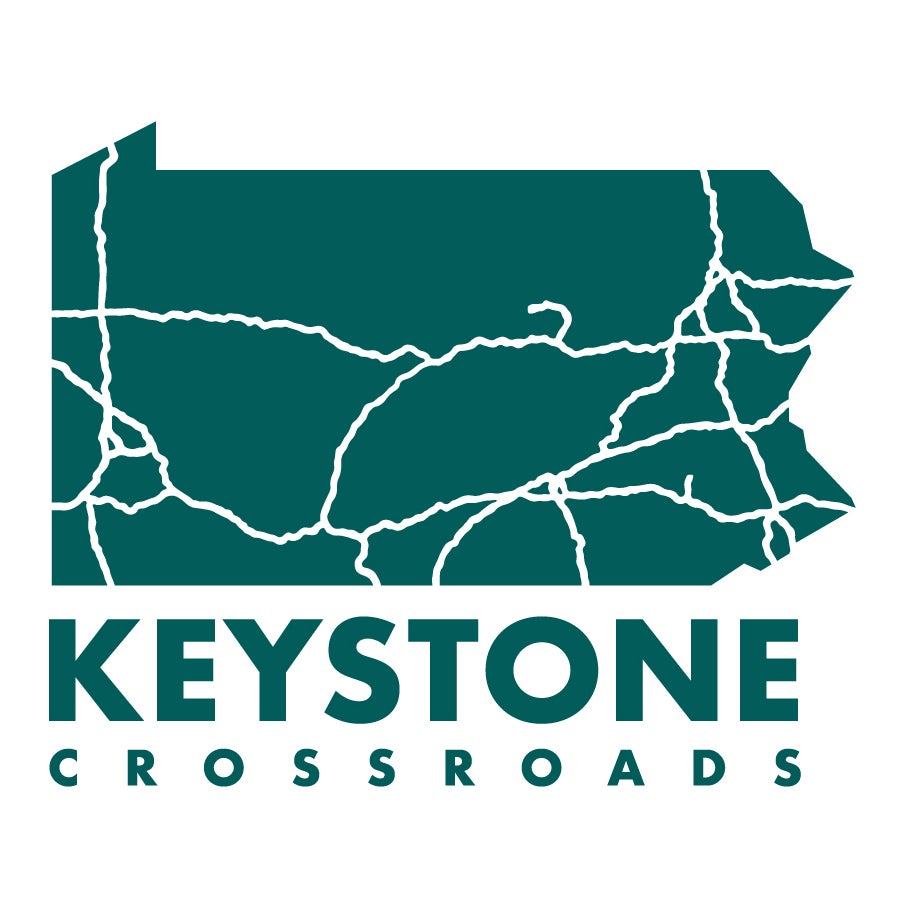
Get more Pennsylvania stories that matter
WHYY is your source for fact-based, in-depth journalism and information. As a nonprofit organization, we rely on financial support from readers like you. Please give today.




